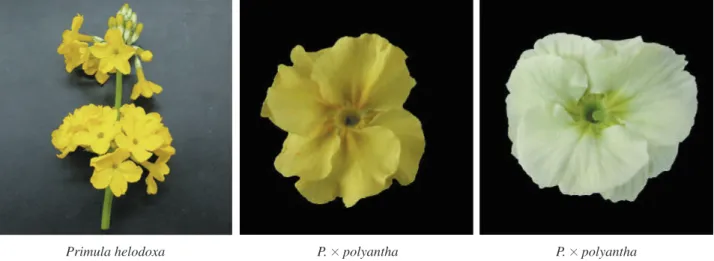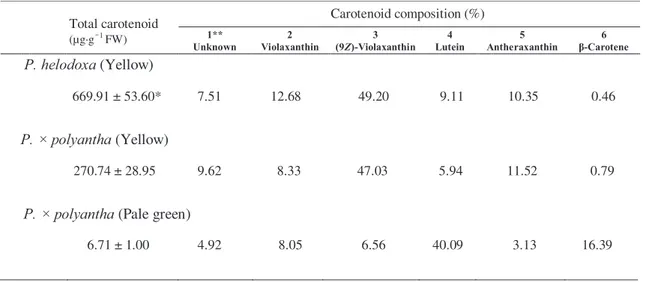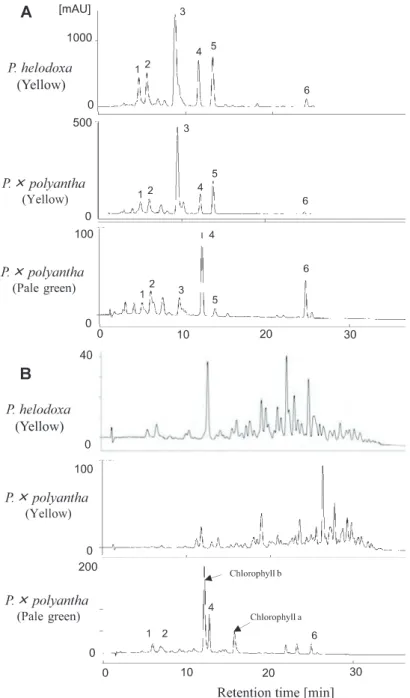研究資料
Carotenoid Composition in the Yellow and Pale Green Petals of Primula Species
Chihiro Y
AMAMIZO, Masumi H
IRASHIMA, Sanae K
ISHIMOTOand Akemi O
HMIYA(Received June 30, 2011 Accepted August 25, 2011)
Summary
The carotenoid composition in the yellow petals of Primula×polyantha and P. helodoxa, and in the pale green petals of P.×polyantha was analyzed by high-performance liquid chromatography. The major carotenoids detected in the yellow petals were (9Z)-violaxanthin, (all-E)-violaxanthin, lutein, and antheraxanthin. The carotenoid composition in the pale green petals was completely different from that in the yellow petals; the former accumulated predominantly lutein and β-carotene. Carotenoids in the yellow petals were present in the esterified form, while those in the pale green petals were in the free form.
Key Words: carotenoid, flower color, Primula
Introduction
Primula is one of the largest plant genera in the northern hemisphere, containing more than 400 species, which are subdivided into 37 sections (Richards, 1993). In Japan, Primula sieboldii has developed into an important ornamental plant, and approximately 300 different cultivars have been produced (Torii, 1985). The petal colors of P. sieboldii are limited to white, pink, and red, and the differences are the result of variations in the concentration of anthocyanin in the petals (Yoshioka et al., 2004). On the other hand, there are some yellow-flowered cultivars of P.×polyantha and yellow-flowered wild species of P. helodoxa. Cao and Liang (2008) reported that the brightness of the yellow color in P. vulgaris is largely determined by the carotenoid content. However, little data is available on the carotenoid profiles in the petals of Primula species. In the present study, we analyzed the carotenoid composition in the yellow petals of P.×polyantha and P. helodoxa by using high-performance liquid chromatography (HPLC). Not only yellow petals but also pale green petals contain carotenoids together with chlorophylls. We then compared the carotenoid composition of the yellow petals with that of the pale green petals of P.×polyantha.
Materials and Methods
1. Plant materials
Yellow- and pale-green-flowered cultivars of the ‘Primrose’ series (P.×polyantha; Japan Agribio Co. Ltd., Tokyo, Japan) and yellow-flowered wild species of P. helodoxa (Fig.1) were purchased from the local market in Tsukuba, Ibaraki, Japan. Petals were harvested and stored at-80℃ until use.
2. Extraction of carotenoids
The petals were ground to powder in 2.0-mL microtubes using a Shake Master BMS-12 (Inter Bio Techno, Tokyo, Japan), and the powder was extracted with acetone. The extract was partitioned between diethyl ether and aqueous NaCl phases. The organic layer was washed with water. Half of the organic layer was dried in a vacuum dryer and dissolved in MeOH for HPLC analysis (unsaponified sample). The rest of the organic layer was saponified with the same volume of 5% KOH-MeOH for 2 h at room temperature in the dark. The
Fig. 1. Photographs of fully opened flowers tested in this study.
Primula helodoxa
(Yellow)
P.×polyantha
(Yellow)
P.×polyantha
(Pale green)
saponified matter was then extracted with diethyl ether and washed with water. The organic layer was dried in a vacuum dryer and dissolved in MeOH for HPLC analysis (saponified sample).
3. HPLC analysis of carotenoids
Each sample was analyzed by HPLC (X-LC, JASCO, Tokyo, Japan) equipped with a photodiode array detector.
The column was a YMC Carotenoid Column (100×4.6 mm, i.d.; 3μm; YMC, Tokyo, Japan). Solvent A was MeOH:(CH3)3COCH3:H2O = 95:1:4 (v/v/v); solvent B was MeOH:(CH3)3COCH3:H2O = 25:71:4 (v/v/v). The gradient was 0/100, 5/100, and 33/0 (min/% solvent A). The flow rate was 1.0 mL•min-1, column temperature was 35℃, and UV/visible monitoring range was 200-750 nm. Peaks were identified by comparing retention times and absorbance spectra with those of previously identified compounds in the petals of Chrysanthemum morifolium (Kishimoto et al., 2004), and with those of standard compounds. The total carotenoid contents were estimated from the total peak area of the HPLC chromatograms at a wavelength of 450 nm, and are expressed as lutein equivalents [μg•g-1 fresh weight (FW)] of the tissue. The percentage of each carotenoid component was calculated according to the peak area of the HPLC chromatograms at a wavelength of 450 nm.
Results and Discussion
At an early stage of development, the petals of all the Primula plants examined were pale green and contained around 10 μg•g-1 FW carotenoids (data not shown). The mature petals of the yellow-flowered P.×polyantha and P.
helodoxa contained high levels of carotenoids (> 270μg•g-1 FW, Table 1), while those of the pale-green-flowered P.×polyantha contained only small amounts (< 7μg•g-1 FW, Table 1). The petals of the yellow-flowered P.×
polyantha and P. helodoxa showed similar carotenoid profiles, predominantly accumulating (9Z)-violaxanthin. The levels of (all-E)-violaxanthin, lutein, and antheraxanthin (Fig. 2A, Table 1) were also high. The HPLC chromatograms of the unsaponified and saponified samples were different. Most of the peaks identified in the saponified sample were absent in the unsaponified samples. This indicates that the majority of carotenoids in the yellow petals are present in the esterified form (Fig. 2B). On the other hand, the major carotenoids in the pale green petals of P.×polyantha were lutein and β-carotene (Fig. 2A, Table 1). The HPLC chromatograms of the unsaponified and saponified samples were similar, indicating that these carotenoids were present in the free form (Fig. 2B).
Table 1. Carotenoid composition in the petals of Primula species
Total carotenoid (µg·g−1 FW)
Carotenoid composition (%)
Unknown 1** 2
Violaxanthin 3
(9Z)-Violaxanthin 4
Lutein 5
Antheraxanthin 6 β-Carotene
P. helodoxa (Yellow)
669.91 ± 53.60* 7.51 12.68 0049.20 9.11 10.35 00.46
P. × polyantha (Yellow)
270.74 ± 28.95 9.62 8.33 0047.03 5.94 11.52 00.79
P. × polyantha (Pale green)
6.71 ± 1.00 4.92 8.05 006.56 40.09 3.13 16.39
* Mean values (±SE) are shown (n = 3).
** Peak numbers correspond to those shown in Fig. 2.
The carotenoid composition in petals differs from species to species, and even between cultivars of the same plant species (Ohmiya, 2011). On the other hand, the leaves of different plant species have similar carotenoid compositions (Goodwin, 1992). The predominant carotenoids in leaves are those essential for photosynthesis, such as lutein and β-carotene. The carotenoid composition of the pale green petals of P.×polyantha was similar to that of the leaves, while the carotenoids in the yellow petals of P.×polyantha and P. helodoxa were different from those in the leaves. Leaf carotenoids are localized in the chloroplasts, while petal carotenoids reside in the chromoplasts. Therefore, we designated the carotenoids in the yellow petals of Primula sp. as “chromoplast-type carotenoids” and those in the pale green petals of Primula sp. as “chloroplast-type carotenoids”. The results are in agreement with a previous study on Ipomoea species (Yamamizo et al., 2010): the petals of the pale-yellow- flowered I. obscura accumulated chloroplast-type carotenoids, while those of the yellow-flowered Ipomoea sp.
accumulated chromoplast-type carotenoids. In leaves, carotenoids and chlorophylls bind to chlorophyll-
Fig. 2. HPLC chromatograms (absorbance at 450 nm) of saponified (A) and unsaponified (B) carotenoid extracts from Primula helodoxa and P.×polyantha. 1: unknown; 2: (all-E)- violaxanthin; 3: (9Z)-violaxanthin; 4: lutein; 5: antheraxanthin; 6: β-carotene.
carotenoid proteins, and are functionally integrated into the thylakoid membrane (Nelson and Yocum, 2006).
Immature petals of I. obscura have a pale green color, and they contain chlorophylls and chloroplast-type carotenoids (Yamamizo et al., 2010). During flower development, the chlorophylls disappear, and chloroplast- type carotenoids persist, while the petals remain pale yellow. In the case of the pale-green-flowered P.×polyantha, we speculate that the carotenoids coexist with the chlorophylls in the chloroplast, because the petals contain chlorophylls (Fig. 2B) even during the later stages of petal development.
Not only did the carotenoid composition differ between the chloroplast- and chromoplast-type carotenoids, but their esterification also differed in the Primula plants tested in this study. Vishnevetsky et al. (1999) reported that the carotenoids contained in chromoplasts are generally esterified and are associated with carotenoid- lipoprotein structures. The importance of esterification for carotenoid sequestration into the chromoplasts has been well documented in pepper fruits (Minguez-Mosquera and Hornero-Méndez, 1994a, b; Hornero-Mendez and Minguez-Mosquera, 2000). The transition from chloroplast (in immature green fruits) to chromoplast (in mature red fruits) was correlated with xanthophyll esterification. However, only a small amount of data is presently available on carotenoid esterification in flowers. In this study, we showed that the chromoplast-type carotenoids in yellow petals existed in the esterified form, while chloroplast-type carotenoids in the pale green petals were in the free form. Similar phenomena were also reported in Ipomoea plants (Yamamizo et al., 2010). Therefore, we assume that esterification is an important process for the sequestration of carotenoids into the chromoplasts in flower petals.
Literature cited
Cao, J.J. and Z.S. Liang. 2008. Preliminary analysis on flower color inheritance and relations between flower color and pigments in Primula vulgaris. Bull. Bot. Res. 28: 426-432.
Goodwin, T.W. 1992. Distribution of carotenoids. In: L. Packer (ed.), Methods in Enzymology, Vol. 213, p. 167-172, Academic Press Inc., San Diego, CA, USA.
Hornero-Méndez, D. and M.I. Mínguez-Mosquera. 2000. Xanthophyll esterification accompanying carotenoid overaccumulation in chromoplast of Capsicum annuum ripening fruits is a constitutive process and useful for ripeness index. J. Biol. Chem. 48:
1617-1622.
Kishimoto, S., T. Maoka, M. Nakayama and A. Ohmiya. 2004. Carotenoid composition in petals of chrysanthemum (Dendranthema grandiflorum (Ramat.) Kitamura). Phytochemistry 65: 2781-2787.
Ménguez-Mosquera, M.I. and D. Hornero-Méndez. 1994a. Formation and transformation of pigments during the fruit ripening of Capsicum annuum cv Bola and Agridulce. J. Agri. Food Chem. 42: 38-44.
Ménguez-Mosquera, M.I. and D. Hornero-Méndez. 1994b. Changes in carotenoid esterification during the fruit ripening of Capsicum annuum cv Bola. J. Agri. Food Chem. 42: 640-644.
Nelson, N and C.F. Yocum. 2006. Structure and function of photosystems I and II. Ann. Rev. Plant Biol. 57: 521-565.
Ohmiya, A. 2011. Diversity of carotenoid composition in flower petals. JARQ 45: 163-171.
Richards, J. 1993. Primula. Timber Press, Portland, OR, USA.
Torii, T. 1985. Sakurasou (in Japanese). Nihon-terebi, Akatsuki-Insatsu Press, Tokyo, Japan.
Vishnevetsky, M., M. Ovadis and A. Vainstein. 1999. Carotenoid sequestration in plants: The role of carotenoid-associated proteins.
Trends Plant Sci. 4: 232-235.
Yamamizo, C., S. Kishimoto and A. Ohmiya. 2010. Carotenoid composition and carotenogenic gene expression during Ipomoea petal development. J. Exp. Bot. 61: 709-719.
Yoshioka, Y., H. Iwata, R. Ohsawa and S. Ninomiya. 2004. Quantitative evaluation of flower colour pattern by image analysis and principal component analysis of Primula sieboldii E. Morren. Euphytica 139: 179-186.
サクラソウ属植物の黄色および黄緑色花弁における カロテノイド組成の比較
山溝千尋・平島真澄・岸本早苗・大宮あけみ
和文摘要
サクラソウ属植物のプリムラ・ポリアンサ(Primula × polyantha)および黄花クリンソウ(P. helodoxa)の花弁の カロテノイド組成をHPLCにより解析した.プリムラ・ポリアンサの黄花品種と黄花クリンソウの花弁は,
(9Z)-violaxanthin,(all-E)-violaxanthin,lutein および antheraxanthinを主成分とする花弁特有のカロテノイド組 成を示した.また,カロテノイドの多くはエステル化された状態で蓄積していた.一方,プリムラ・ポリアンサの黄 緑花品種の花弁は,葉と同様のカロテノイド組成および存在形態を示した.すなわち,luteinとβ-caroteneを主成 分とし,その多くはエステル化されていない遊離の状態で存在していた.


